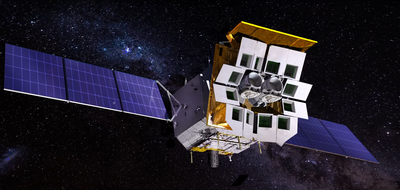
Search
Einstein Probe

The Einstein Probe (EP) is an X-ray space telescope mission by Chinese Academy of Sciences (CAS) in partnership with European Space Agency (ESA) and the Max Planck Institute for Extraterrestrial Physics (MPE) dedicated to time-domain high-energy astrophysics. The primary goals are "to discover high-energy transients and monitor variable objects". The telescope was launched by a Long March 2C rocket from the Xichang Satellite Launch Centre in China, on 9 January 2024, at 07:03 UTC.
Scientific objectives
The primary science objectives are:
- Identify inactive black holes to study how matter is precipitated there by detecting the transient events that take the form of X-ray flares;
- Detect the electromagnetic counterpart of events triggering gravitational waves such as the merger of neutron stars which will be discovered by the next generation of gravitational wave detectors;
- Carry out permanent monitoring of the entire sky to detect the various transient phenomena and carry out measurements of known variable X-ray sources.
Instruments
Einstein Probe carries 2 scientific instruments: the Wide-field X-ray Telescope (WXT), and the Follow-up X-ray Telescope (FXT). Both telescopes utilize X-ray focusing optics.
- Wide-field X-ray Telescope (WXT): WXT has a new optics design, called "lobster-eye", that has wider field of view. "Lobster-eye" optics was first tested by the Lobster Eye Imager for Astronomy (LEIA) mission, launched in 2022. WXT consists of 12 Lobster-eye optics sensor modules, together creating a very large instantaneous field-of-view of 3600 square degrees. The nominal detection bandpass of WXT is 0.5~4.0 keV. Each module weighs 17 kg and has an electrical power consumption of just under 13 W. With the peripherals, the entire telescope weighs 251 kg and has a power consumption of 315 W.
- Follow-up X-ray Telescope (FXT): FXT has optics adopted from eROSITA, "the mirror module consists of 54 nested Wolter mirrors with a focal length of 1600 mm and an effective area of greater than 300 cm2 at 1.5 keV."
The probe weights 1450 kg and is 3-by-3.4 metres.
Launch
Einstein Probe was launched on 9 January 2024, at 07:03 UTC by a Long March 2C rocket from the Xichang Satellite Launch Centre in China, and successfully placed in low Earth orbit at an altitude of 600 km and an inclination of 29 degrees, giving an orbital period of 96 minutes.
First results
CAS reported that EP "performs as expected in the first month". The probe detected fast X-ray transient EP240315a, and bright X-ray flares EP240305a and EPW20240219aa.
See also
- Timeline of artificial satellites and space probes
- List of things named after Albert Einstein
- X-ray astronomy
- List of space telescopes#X-ray
References
Further reading
- Yuan, Weimin; Zhang, Chen; Chen, Yong; Ling, Zhixing (2022). "The Einstein Probe Mission". Handbook of X-ray and Gamma-ray Astrophysics. pp. 1–30. arXiv:2209.09763. doi:10.1007/978-981-16-4544-0_151-1. ISBN 978-981-16-4544-0.
External links
- Official website at NAOC, CAS. Archived January 2, 2022, at the Wayback Machine
- Einstein Probe at ESA.int
- Einstein Probe at MPE.MPG.de
Text submitted to CC-BY-SA license. Source: Einstein Probe by Wikipedia (Historical)
Articles connexes
- Einstein (disambiguation)
- List of things named after Albert Einstein
- Joint Dark Energy Mission
- List of spaceflight launches in January–June 2024
- Albert Einstein
- 2024 in spaceflight
- Beyond Einstein program
- Gravity Probe A
- List of space telescopes
- SpaceX Crew-8
- Lobster-eye optics
- Lobster Eye Imager for Astronomy
- Chang'e 6
- Introduction to general relativity
- Shenzhou 18
- Mass–energy equivalence
- Brain of Albert Einstein
- INSAT-3DS
- Timeline of artificial satellites and space probes
- X-ray telescope
Owlapps.net - since 2012 - Les chouettes applications du hibou




